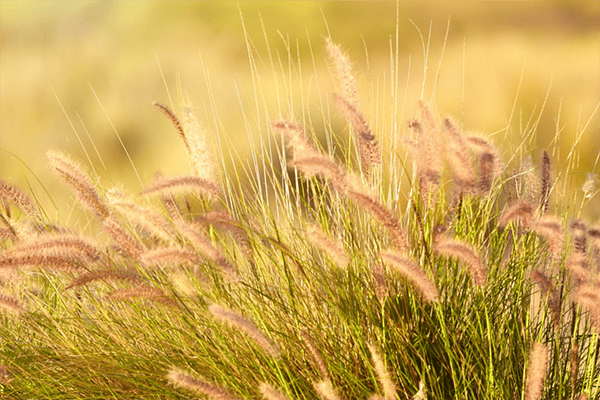
Nothing to Sneeze At: Forecasting Allergy Seasons Amid a Changing Climate
Graduate student Yingxiao Zhang is developing a better way to forecast allergy season to help people better navigate its headaches.

Graduate student Yingxiao Zhang is developing a better way to forecast allergy season to help people better navigate its headaches.
The first blossoms of spring are often a welcome sight, signaling the end of winter, the return of warm weather, and a splash of long-absent color to our landscapes. For many, however, springtime joy lasts only until the first gust of wind stirs the fresh growth under their feet and over their heads, wafting a cloud of fine greenish-yellow dust into the air—pollen.
That’s when the symptoms begin. Headache, sore throat, sinus pressure, runny nose, watery eyes. At best, seasonal allergies are an uncomfortable inconvenience as people go about their days; at worst, they can be severe enough to interfere with job performance and personal lives. Going beyond the personal, seasonal allergies have measurable medical and economic consequences: A 2011 study published in Annals of Allergy, Asthma, and Immunology found the medical costs associated with allergic rhinitis to be $3.4 billion annually, and a 2010 study published in Respiratory Medicine showed the same condition accounted for nearly 18 sick days per capita.
And it’s set to get worse. The rising temperatures and atmospheric carbon dioxide associated with climate change are shortening winters, lengthening growing seasons, and encouraging plant life. A study published last year in Nature Communications by atmospheric scientists in the U-M Department of Climate and Space Sciences and Engineering (CLASP) determined that, if climate change continues apace, the United States will see a 200 percent increase in total pollen over the course of the next century, with pollen season beginning up to 40 days earlier and enduring 19 days longer than it currently does.
To help people around the country better navigate the perils of a worsening pollen season, Yingxiao Zhang, a doctoral student in CLASP and co-author of the Nature Communications study, is working with a team of U-M researchers including Professor Allison Steiner, Ph.D., to develop improved ways to forecast both its duration and intensity.
>> In the Media: “Worsening Allergies Tied to Climate Change and Severe Weather”
“So many people have these allergies, building a better forecast will help them get accurate information for their communities and prepare ahead of time,” she says. “We want to ultimately integrate a pollen model into the air quality forecasting system so people can track it alongside other common pollutants and irritants.”

Pollen forecasts have existed for some time, but have always been hampered by insufficient reliable data, Zhang says. Pollen counts have only been taken in the U.S. for about a decade, collected from only about 200 nationwide observation sites, and only yield a general result, rather than one that reflects the pollen of specific species. That means historically, unless a person lives near one of those sites, they have little way of knowing the conditions in their region.
Zhang and her colleagues are attempting to rectify this by combining pollen counts with climate data, precipitation, carbon dioxide levels, and vegetation distribution. The association between these different sources reveals information on how conditions like temperature or precipitation impact pollen levels.
As the impact of climate change is not equal on all plant species across all regions, the team is focusing their observations on a selection of 15 species of grasses and trees, including sycamore, birch, and ragweed. Taken together, they account for about 70 percent of airborne pollen in the U.S. As the prevalence of each species varies across the country, understanding how each reacts to changes in weather and climate provides a more accurate forecast for different regions.
The results are both promising and concerning. While all regions of the country will be impacted, the models developed by Zhang and her colleagues show the most severe will occur in the Southeast and some northern regions.

These maps, produced by Zhang and her advisor, show the average pollen season length of three common plants on the left, and the expected change in that season by the end of the century on the right.
“Because northern regions are expected to see larger increases in temperature, plant growing seasons will extend more compared to the south,” Zhang says. “Another factor common in places like the northeast U.S. is that generally one species of tree, like maple, will start to emit pollen first, and then another, like oak, follows it. However, with warmer temperatures, we expect to see more overlapping of these species, putting much more pollen in the air at once.”
As their research continues, the team has begun to work with the National Oceanic and Atmospheric Administration (NOAA) to incorporate their findings into the weather forecasting system for the entire country.
“At the end of the day, our primary aim is to make this knowledge accessible to people,” Zhang says. “When I first became a Ph.D. student, it seemed like it would be about a lot of coding, gathering data, finding results. But as our studies have progressed, I’ve been able to talk to a lot of different people about it—journalists, collaborators at places like NOAA, even high school teachers who have included our work in their textbooks and curricula. Seeing that our work makes a difference in people’s lives, that it can make their lives better, is the most rewarding part.”
“We often think of climate change as impacting in the far-away future, but it’s happening around us right now, in the air right here. My hope is this shows people another consequence of climate change and its impact on human life, and that it can help us navigate that impact.”
Original article by James Dau posted on Rackham Graduate School